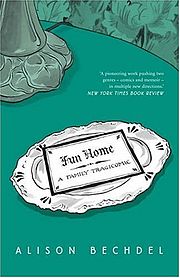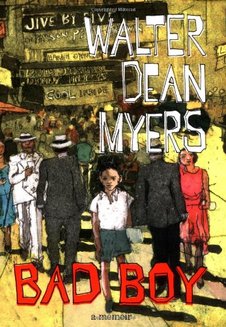
Fun Home by Alison Bechdel
ISBN: 0-618-47794-2
Bechdel, A. (2006). Fun home: A family tragicomedy. New York: Houghton Mifflin
Plot Summary
Alison Bechdel chronicles her childhood and youth growing up in rural Pennsylvania. It also focuses on Bechdel’s relationship with her father. The book starts with Bruce Bechdel’s obsession with renovating the family’s Victorian home. Alison notes that his manic obsessive behavior also reflected itself in the way he treated his family. As Alison grows older, she realizes her father is not like other fathers. He is very concerned with her acting obviously female, to the point where he berates her for not wearing hairclips. She describes her relationship with Bruce as being so completely opposite that they almost complemented each other. While she thrilled in simple, clean, and mannish, Bruce was ornate, decadent, and almost frilly. The Victorian house was all Bruce wanted. They were constantly at odds with one another while Alison was growing up, and never agreed on anything. A large focus is on Alison’s growing awareness of her sexuality and development. Before Bruce commits suicide, Alison and he have a conversation where he explains some of his sexuality and past experiences. Though not fully explored, tensions between the two dissipate somewhat. However, Bruce’s apparent suicide a few weeks later causes Alison to question whether or not admitting she was a lesbian triggered her father’s actions.
Critical Evaluation
The story does not follow a chronological path, and events are retold as Bechdel grows older and learns more information that sheds light on previous events. Bechdel holds nothing back, is direct, and unapologetic. This is her life, as she has lived it, including the good, the bad, the beautiful, and the ugly, but all of it the truth. A unique form for a memoir, the graphic novel aspect adds something extra to what is already some serious subject matter. As with picture books, Bechdel’s graphics show, rather than tell, many of the nuances of human interaction and life. There are moments of comedy and humor, but there are plenty of grim realizations as well. Many famous literary works or plays are also mentioned, and similarities drawn to various family members, especially Bechdel’s parents. These serve to illustrate a point, or make a reference others can identify with. The artwork is also deeply inspired. For each illustration, Bechdel first photographed herself dressed as her family, then drew each picture, and used Photoshop and Adobe Illustrator at various stages. She also used Google Images to find period photographs of places, and hand-copied letters and journal excerpts. The result is a carefully planned and meticulously executed story told in pictures.
Reader’s Annotation
A memoir in graphic novel format, Fun Home is direct, unapologetic, and holds nothing back.
About the Author
“Since its inception in 1983, Alison Bechdel’s comic strip Dykes To Watch Out For has become a countercultural institution. The strip is syndicated in dozens of newspapers, translated into several languages and collected in a series of award-winning books. Utne magazine has listed DTWOF as “one of the greatest hits of the twentieth century.” And Comics Journal says, “Bechdel’s art distills the pleasures of Friends and The Nation; we recognize our world in it, with its sorrows and ironies.”
In addition to her comic strip, Bechdel has also done exclusive work for a slew of publications, including Ms., Slate, the Advocate, and many other newspapers, websites, comic books, and ‘zines. In 2006, Houghton Mifflin published her graphic memoir, Fun Home: A Family Tragicomic. The bestselling coming-of-age tale has been called a “mesmerizing feat of familial resurrection” and a “rare, prime example of why graphic novels have taken over the conversation about American literature. Bechdel lives near Burlington, Vermont.”
Genre
Memoir/Graphic novel/Adult crossover
Curriculum Ties
Literature and Writing Styles
Photography and Art Composition
Booktalking
Compare and contrast Alison's understanding of her sexuality with that of her father's.
What are some unique experiences growing up in a funeral home?
Reading Level/Interest Level
RL: N/A
IL: 10th grade and up
Challenge Issues
Possible challenge issues include homosexuality, homosexual relationships, graphic language, sexual situations, and suicide.
In my defense file, I would include the following:
1) Library Mission Statement
2) Library Selection Policy approved by any or all of the following individuals—principal, school board, district librarian OR library manager, city council, mayor.
3) Library Bill of Rights adapted from CSLA Bill of Rights, AASL Bill of Rights and/or ALA Bill of Rights
4) Reviews, both positive and critical, from respected sources such as School Library Journal, VOYA, Booklist
5) Rationale for book inclusion for titles anticipated to be controversial, frequently challenged, or created when a book is challenged including: summary, audience, purpose, controversial issues and how they are handled
6) How the book fits within Common Core Standards or State Standards
7) Reconsideration form for challenger to complete—include a section asking which part was of particular concern, if the entire book was read, and what other similar titles are suggested instead
8) Student reviews from those who have read the book and either enjoyed or disliked the book and why.
Why Included
This book hit a number of categories- graphic novel, memoir, LGBT, and crossover. It is a controversial choice for teens, but I think it is worthwhile.
Others in the Series
N/A
References
Bechdel, A. (2013). Alison bechdel. Retrieved from http://dykestowatchoutfor.com/alison-bechdel.
ISBN: 0-618-47794-2
Bechdel, A. (2006). Fun home: A family tragicomedy. New York: Houghton Mifflin
Plot Summary
Alison Bechdel chronicles her childhood and youth growing up in rural Pennsylvania. It also focuses on Bechdel’s relationship with her father. The book starts with Bruce Bechdel’s obsession with renovating the family’s Victorian home. Alison notes that his manic obsessive behavior also reflected itself in the way he treated his family. As Alison grows older, she realizes her father is not like other fathers. He is very concerned with her acting obviously female, to the point where he berates her for not wearing hairclips. She describes her relationship with Bruce as being so completely opposite that they almost complemented each other. While she thrilled in simple, clean, and mannish, Bruce was ornate, decadent, and almost frilly. The Victorian house was all Bruce wanted. They were constantly at odds with one another while Alison was growing up, and never agreed on anything. A large focus is on Alison’s growing awareness of her sexuality and development. Before Bruce commits suicide, Alison and he have a conversation where he explains some of his sexuality and past experiences. Though not fully explored, tensions between the two dissipate somewhat. However, Bruce’s apparent suicide a few weeks later causes Alison to question whether or not admitting she was a lesbian triggered her father’s actions.
Critical Evaluation
The story does not follow a chronological path, and events are retold as Bechdel grows older and learns more information that sheds light on previous events. Bechdel holds nothing back, is direct, and unapologetic. This is her life, as she has lived it, including the good, the bad, the beautiful, and the ugly, but all of it the truth. A unique form for a memoir, the graphic novel aspect adds something extra to what is already some serious subject matter. As with picture books, Bechdel’s graphics show, rather than tell, many of the nuances of human interaction and life. There are moments of comedy and humor, but there are plenty of grim realizations as well. Many famous literary works or plays are also mentioned, and similarities drawn to various family members, especially Bechdel’s parents. These serve to illustrate a point, or make a reference others can identify with. The artwork is also deeply inspired. For each illustration, Bechdel first photographed herself dressed as her family, then drew each picture, and used Photoshop and Adobe Illustrator at various stages. She also used Google Images to find period photographs of places, and hand-copied letters and journal excerpts. The result is a carefully planned and meticulously executed story told in pictures.
Reader’s Annotation
A memoir in graphic novel format, Fun Home is direct, unapologetic, and holds nothing back.
About the Author
“Since its inception in 1983, Alison Bechdel’s comic strip Dykes To Watch Out For has become a countercultural institution. The strip is syndicated in dozens of newspapers, translated into several languages and collected in a series of award-winning books. Utne magazine has listed DTWOF as “one of the greatest hits of the twentieth century.” And Comics Journal says, “Bechdel’s art distills the pleasures of Friends and The Nation; we recognize our world in it, with its sorrows and ironies.”
In addition to her comic strip, Bechdel has also done exclusive work for a slew of publications, including Ms., Slate, the Advocate, and many other newspapers, websites, comic books, and ‘zines. In 2006, Houghton Mifflin published her graphic memoir, Fun Home: A Family Tragicomic. The bestselling coming-of-age tale has been called a “mesmerizing feat of familial resurrection” and a “rare, prime example of why graphic novels have taken over the conversation about American literature. Bechdel lives near Burlington, Vermont.”
Genre
Memoir/Graphic novel/Adult crossover
Curriculum Ties
Literature and Writing Styles
Photography and Art Composition
Booktalking
Compare and contrast Alison's understanding of her sexuality with that of her father's.
What are some unique experiences growing up in a funeral home?
Reading Level/Interest Level
RL: N/A
IL: 10th grade and up
Challenge Issues
Possible challenge issues include homosexuality, homosexual relationships, graphic language, sexual situations, and suicide.
In my defense file, I would include the following:
1) Library Mission Statement
2) Library Selection Policy approved by any or all of the following individuals—principal, school board, district librarian OR library manager, city council, mayor.
3) Library Bill of Rights adapted from CSLA Bill of Rights, AASL Bill of Rights and/or ALA Bill of Rights
4) Reviews, both positive and critical, from respected sources such as School Library Journal, VOYA, Booklist
5) Rationale for book inclusion for titles anticipated to be controversial, frequently challenged, or created when a book is challenged including: summary, audience, purpose, controversial issues and how they are handled
6) How the book fits within Common Core Standards or State Standards
7) Reconsideration form for challenger to complete—include a section asking which part was of particular concern, if the entire book was read, and what other similar titles are suggested instead
8) Student reviews from those who have read the book and either enjoyed or disliked the book and why.
Why Included
This book hit a number of categories- graphic novel, memoir, LGBT, and crossover. It is a controversial choice for teens, but I think it is worthwhile.
Others in the Series
N/A
References
Bechdel, A. (2013). Alison bechdel. Retrieved from http://dykestowatchoutfor.com/alison-bechdel.

 RSS Feed
RSS Feed